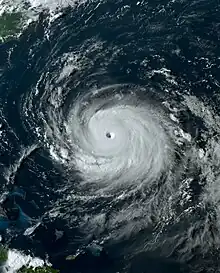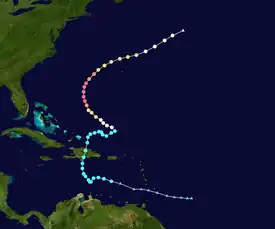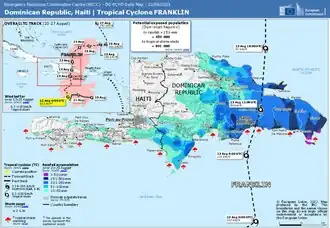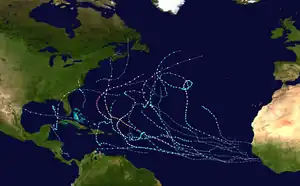 Franklin shortly before attaining peak intensity on August 28 | |
| Meteorological history | |
|---|---|
| Formed | August 20, 2023 |
| Extratropical | September 1, 2023 |
| Dissipated | September 9, 2023 |
| Category 4 hurricane | |
| 1-minute sustained (SSHWS/NWS) | |
| Highest winds | 150 mph (240 km/h) |
| Lowest pressure | 926 mbar (hPa); 27.34 inHg |
| Overall effects | |
| Fatalities | 2 |
| Missing | 1 |
| Damage | $90 million (2023 USD) |
| Areas affected | |
Part of the 2023 Atlantic hurricane season | |
Hurricane Franklin was a long-lived, erratic, and powerful hurricane that brought tropical-storm force winds to parts of the Greater Antilles and Bermuda. The seventh named storm,[1] second hurricane and first major hurricane of the 2023 Atlantic hurricane season, Franklin impacted Hispaniola as a tropical storm before strengthening into a high-end Category 4 hurricane several days later. Possessing a large wind field, the hurricane produced tropical storm force winds over Bermuda and soon became extratropical as it accelerated into the open northern Atlantic.
Franklin brought heavy rainfall and wind, causing damage to buildings, homes, and light posts.[2] Two fatalities were reported in the Dominican Republic, with an additional person also missing.[2] At least 350 people were displaced, and more than 500 homes and 2,500 roads were affected or damaged.[3] Several communities in the Dominican Republic were cut off, and nearly 350,000 homes were left without power, with an additional 1.6 million homes cut off from potable water.[3]
Meteorological history

Tropical storm (39–73 mph, 63–118 km/h)
Category 1 (74–95 mph, 119–153 km/h)
Category 2 (96–110 mph, 154–177 km/h)
Category 3 (111–129 mph, 178–208 km/h)
Category 4 (130–156 mph, 209–251 km/h)
Category 5 (≥157 mph, ≥252 km/h)
Unknown
On August 17, the National Hurricane Center (NHC) began monitoring an elongated trough of low pressure located well to the east-southeast of the Lesser Antilles for the possibility of slow development.[4] An area of low pressure formed on August 19 east of the Leeward Islands, and after entering the Caribbean Sea on August 20, the disturbance organized into Tropical Storm Franklin.[5][6] Over the next couple of days, Franklin drifted through weak steering currents, while battling moderate wind shear. This gave the cyclone a disheveled appearance with most of convection to the east of its center and the NHC noted multiple times that Franklin may have not had a well-defined center of circulation on August 22.[7] Early on August 23, the storm began moving northwestward before turning northward, becoming somewhat better organized, allowing it to intensify. Franklin then made landfall with maximum sustained winds of 50 mph (80 km/h) south of Barahona, Dominican Republic, shortly before 12:00 UTC on August 23.[8][9]

Weakening occurred after Franklin made landfall, and it emerged into the Atlantic Ocean at 21:00 UTC as a minimal tropical storm.[10] After drifting eastward and struggling with strong westerly shear and land interaction for several days, Franklin entered a more favorable environment for development on August 25 and promptly intensified into a Category 1 hurricane the next morning.[11] A further decrease in wind shear along with less dry air allowed Franklin to begin to rapidly intensify as it moved northwestward, becoming the season's first major hurricane at 09:00 UTC on August 28.[12] Franklin then began to intensify even more rapidly, becoming a category 4 hurricane just over 2+1⁄2 hours later.[13] Franklin then turned northward reached its peak intensity shortly afterwards with maximum sustained winds of 150 mph (240 km/h) and an estimated central pressure of 926 mbar (27.34 inHg) before initiating an eyewall replacement cycle, causing it to begin to slowly weaken as it turned northeastward. That trend continued after the cycle was completed as northerly wind shear from the outflow from Hurricane Idalia to the southwest increased over Franklin and by 09:00 UTC on August 30, it had weakened to Category 2 strength.[14] The following day, while passing north of Bermuda, the wind shear over Franklin increased even further, causing the storm's eye to disappear as it became increasingly asymmetric and its forward speed to accelerate.[15]
That same day, Franklin began losing its tropical characteristics, and by 21:00 UTC on September 1 it had become a hurricane-force extratropical cyclone.[16] Shortly thereafter, the strong cyclone absorbed the smaller and weaker Tropical Storm Jose, which was situated to its east, following a brief Fujiwhara interaction.[17][18] Afterward, the system accelerated towards the northeast. By September 4, it was located north of the Azores, then, it moved southeastward to near the northwestern coast of Spain three days later. As the system was moving over warmer waters at the time, the NHC began to monitor it again for possible redevelopment.[19] Some reorganization did take place,[20] but the system did not regenerate into a tropical or subtropical cyclone. The NHC stopped monitoring the post-tropical cyclone as it moved northward on September 7,[21] and the remnant cyclone dissipated two days later.
Preparations and impact
Dominican Republic

Schools, governmental buildings, and airports were closed until August 24.[22][23] In the Dominican Republic, more than 200 people were in shelters, and 24 of the 31 provinces in the country were under a red alert.[23][24] Around 3,300 residents in low-lying areas were evacuated to higher grounds ahead of the storm.[25] An additional 352 people were in government shelters.[26]
Franklin brought heavy rainfall and wind, causing damage to buildings and homes,[27] leaving numerous communities isolated.[26] Nearly 350,000 homes were left without power and 1.6 million homes were cut off from potable water.[3] Around 830,000 aqueduct users were affected after close to 120 aqueducts were put out of service.[23][25] Santo Domingo recorded 330.7 mm (13.02 in) of rain from Franklin.[28] Two people, including a teenager, were killed. A 15-year-old boy died after falling into the Rio Nigua, while another man was killed in San Cristóbal as he attempted to cross a ravine. Another man remains missing after he fell into a ravine in Santo Domingo Oeste.[29] The government reported that storm damage amounted to RD$5,100 million ($90 million).[30]
Haiti
The Haitian Civil Protection Agency warned residents of strong winds and rains expected as the storm made landfall. Haitian prime minister Ariel Henry urged residents to stock up on essential items such as food, water, and medications.[31]
Bermuda
Several flights departing for Bermuda were cancelled. Franklin brought tropical-storm-force winds to the island's northern shores on August 30,[32] causing scattered power outages to 300 residences.[33] Several boat cruise routes that departed for Bermuda were affected due to Franklin.[34]
Elsewhere
On August 30, Kathy Hochul, governor of New York, ordered swimming to be prohibited at Jones Beach State Park, Robert Moses State Park and Hither Hills State Park due to the risk of rip currents. The Town of Hempstead also shut down all beaches to swimming.[35] The beaches reopened on September 1.[36] Several beaches in New Jersey also closed to swimming, with one beach being completely closed.[37]
See also
- Weather of 2023
- Tropical cyclones in 2023
- Timeline of the 2023 Atlantic hurricane season
- List of Category 4 Atlantic hurricanes
- Hurricane Hortense (1996) – Category 4 hurricane, similar track early on
- Hurricane Fiona (2022) – Category 4 hurricane, similar track early on
References
- ↑ Alcántara, Martín Adames (August 24, 2023). "Dominican officials inspect damage inflicted by Tropical Storm Franklin after heavy flooding kills 2". AP News. Retrieved August 27, 2023.
- 1 2 "Dominican officials inspect damage inflicted by Tropical Storm Franklin after heavy flooding kills 2". AP News. August 23, 2023. Retrieved August 25, 2023.
- 1 2 3 "Tropical Storm Franklin Lashes Dominican Republic, Displacing Hundreds". New York Times. Retrieved August 24, 2023.
- ↑ Papin, Philippe (August 17, 2023). "Seven-Day Graphical Tropical Weather Outlook". National Hurricane Center. Retrieved August 22, 2023.
- ↑ Kelly; Brown. "Seven-day Graphical Tropical Weather Outlook". National Hurricane Center. Retrieved August 22, 2023.
- ↑ "Seven-day Graphical Tropical Weather Outlook". www.nhc.noaa.gov. Retrieved August 22, 2023.
- ↑ Berg. "Tropical Storm Franklin Discussion Number 9". www.nhc.noaa.gov. National Hurricane Center. Retrieved August 28, 2023.
- ↑ Berg. "Tropical Storm Franklin Intermediate Advisory Number 11A". www.nhc.noaa.gov. National Hurricane Center. Retrieved August 28, 2023.
- ↑ Cappucci, Matthew (August 23, 2023). "Tropical Storm Franklin makes landfall, brings flooding to Haiti and Dominican Republic". Washington Post. Retrieved August 23, 2023.
- ↑ Papin. "Tropical Storm Franklin Advisory Number 13". www.nhc.noaa.gov. National Hurricane Center. Retrieved August 28, 2023.
- ↑ Oberholtz, Chris; Barker, Aaron; Scott, Sistek (August 26, 2023). "Franklin strengthens to hurricane along trek between US and Bermuda; dangerous rip current threat remains". FOX Weather. Retrieved August 26, 2023.
- ↑ Papin. "Hurricane Franklin Advisory Number 31". www.nhc.noaa.gov. National Hurricane Center. Retrieved August 28, 2023.
- ↑ Kelly; Brown. "Hurricane Franklin Tropical Cyclone Update". www.nhc.noaa.gov. National Hurricane Center. Retrieved August 28, 2023.
- ↑ Papin, Philippe (August 30, 2023). Hurricane Franklin Discussion Number 39 (Report). Miami, Florida: National Hurricane Center. Retrieved August 30, 2023.
- ↑ Papin. "Hurricane Franklin Discussion Number 43". www.nhc.noaa.gov. National Hurricane Center. Retrieved September 1, 2023.
- ↑ Reinhart, Brad (September 1, 2023). Post-Tropical Cyclone Franklin Discussion Number 49 (Report). Miami, Florida: National Hurricane Center. Retrieved September 3, 2023.
- ↑ Bucci, Lisa (September 1, 2023). Remnants Of Jose Discussion Number 15 (Report). Miami, Florida: National Hurricane Center. Retrieved September 3, 2023.
- ↑ Jones, Judson (September 1, 2023). "Tropical Storm Jose Is Absorbed by Another Storm". The New York Times. Retrieved September 3, 2023.
- ↑ Blake, Eric (September 4, 2023). Tropical Weather Outlook (Report). Miami, Florida: National Hurricane Center. Retrieved September 4, 2023.
- ↑ Kelly; Brown. "NHC Graphical Outlook Archive 200 PM EDT Wed Sep 6 2023". www.nhc.noaa.gov. National Hurricane Center. Retrieved September 15, 2023.
- ↑ Kelly. "NHC Graphical Outlook Archive 200 PM EDT Thu Sep 7 2023". www.nhc.noaa.gov. National Hurricane Center. Retrieved September 15, 2023.
- ↑ Coto, Dánica; Sanon, Evens (August 22, 2023). "Tropical Storm Franklin nears the Dominican Republic and Haiti bringing torrential rain". AP News. Retrieved August 23, 2023.
- 1 2 3 "Tropical Storm Franklin lashing Dominican Republic, Haiti; see storm's projected path". USA TODAY. Retrieved August 23, 2023.
- ↑ "Tropical Storm Franklin makes landfall, dumping heavy rain on Haiti and the Dominican Republic". AP News. August 23, 2023. Retrieved August 23, 2023.
- 1 2 Alcántara, Martín Adames (August 24, 2023). "Dominican officials inspect damage inflicted by Tropical Storm Franklin after heavy flooding kills 2". Associated Press. Retrieved August 24, 2023.
- 1 2 "Dominican Republic: Authorities assess damage from Tropical Storm Franklin". www.aljazeera.com. Retrieved August 25, 2023.
- ↑ "At least 1 person is dead and 2 are missing as Tropical Storm Franklin batters Dominican Republic". AP News. August 23, 2023. Retrieved August 24, 2023.
- ↑ Marvell, Pearl (August 25, 2023). "Tropical Storm Franklin leaves a body count and damage in the Caribbean » Yale Climate Connections". Yale Climate Connections. Retrieved September 1, 2023.
- ↑ "Storm Franklin leaves 2 dead and 3,390 displaced". Dominican Today. August 27, 2023. Retrieved September 13, 2023.
- ↑ Javier Flores (August 29, 2023). "Daños por tormenta Franklin asciendan a más de RD$5,000 millones de pesos". Listin Diario.
- ↑ "Franklin makes landfall, brings heavy rain to Dominican Republic and Haiti". Al Jazeera. August 23, 2023. Archived from the original on August 24, 2023. Retrieved August 24, 2023.
- ↑ "Hurricane Franklin cranks past Bermuda as a Category 2 storm". AP News. August 30, 2023. Retrieved August 30, 2023.
- ↑ Jonathan Bell; Sékou Hendrickson (August 31, 2023). "Island dodges worst of Franklin". The Royal Gazette. Retrieved August 30, 2023.
{{cite news}}: CS1 maint: multiple names: authors list (link) - ↑ Mayntz, Melissa (August 29, 2023). "Two Hurricanes Affecting Multiple Cruise Ships and Ports". Cruise Hive. Retrieved September 1, 2023.
- ↑ Long Island ocean beaches closed to swimming as Hurricane Franklin churns up the surf, officials say, Newsday, August 30, 2023
- ↑ Swimming resumes at Long Island state beaches as Hurricane Franklin set to weaken, PoliticoPro, September 1, 2023
- ↑ Wall, Karen (August 29, 2023). "Hurricane Franklin Affecting Beach Access In Ocean County". Patch. Retrieved November 9, 2023.
External links
 Media related to Hurricane Franklin (2023) at Wikimedia Commons
Media related to Hurricane Franklin (2023) at Wikimedia Commons
